THE OLYMPIAN





U.S. Olympians and Paralympians Association President

Dear U.S. Olympians and Paralympians,
Olympic Day began on June 23, 1894: On this date, the participants in the International Athletics Congress in Paris voted unanimously to re-establish the Olympic Games as proposed by Pierre de Coubertin. It is thus the birth date of the modern Olympic Movement.
June 23, 1948: This is the date of the first World Olympic Day, approved by the 42nd IOC Session in St Moritz, Switzerland, in January 1948. The International Olympic Committee as an annual celebration commemorates the origin of the modern Olympic Games. It has quickly grown in the United States and this year will reach 706 events with approximately 555 Olympians, Paralympians hopefuls and coaches participating. Thank you to all our members that have joined in this celebration and are fostering Olympism at these events.
Olympism is a modern word coined from the philosophy of the Olympic Games and the Olympic and Paralympic athletes. Olympism is a way of life that teaches the Olympic values of excellence friendship and respect. Olympic Day is an important opportunity for all of our Olympians and Paralympians to teach these Olympic values to our youth.
The USOPA’s mission is threefold: to foster Olympism, motivate and encourage youth, and honor our fellow members. There are also seven other objectives outlined in our constitution, but these three goals are the highest priority.
Another platform that enables us to foster Olympism and encourage youth is World Fit. The World Fit Walk is a school-based fitness initiative targeting Grades 3-8, and features a visit from an Olympic athlete and a six-week competitive walking/exercise program.
Forty schools participated in the 2014 program, including 15,000 students, who logged more than one million miles. We would like to thank all of the Olympians and Paralympians who volunteered their time and effort to help reverse the epidemic of childhood obesity through the World Fit Walk.
There are also several other state and community organized events that invite participation from our Olympic and Paralympic members. We encourage you to get involved in your community as we rely on your participation to fulfill our mission.
Finally, I want to congratulate Dean Willeford, Carrie Zimmerman and Misty Hyman on their election as presidents of the USOPA chapters in Nevada, Florida and Arizona. We welcome you all and look forward to your contributions to the USOPA.
Yours in Olympic Spirit,
Gary Hall, Sr.
U. S. Olympians and Paralympians Association President
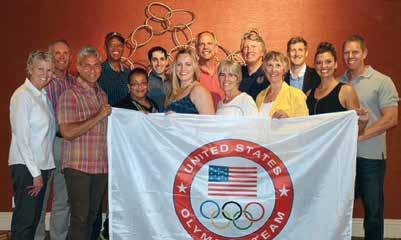
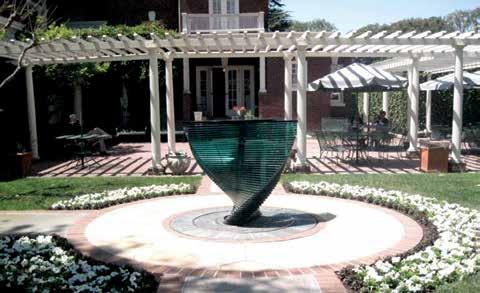 By Laurel Brassey Iversen
By Laurel Brassey Iversen
First, we want to congratulate the United States Olympic Committee and LA84 Foundation on the organization of the U.S. Olympic Academy in Los Angeles. The one-day seminar on
athlete development was well organized and informative. The speakers were well prepared and very professional, while the caliber of participants was impressive and the facility was beautiful. Fortunately, International
Olympic Academy Director Mr. Dionyssis Gangas was a guest speaker and we enjoyed taking him to dinner and offering our hospitality for his first visit to Los Angeles.
Approximately 100 people attended the seminar, including many U.S. Olympians, Paralympians, National Governing Body executives, USOC staff and LA84 staff, which was held at the LA84 Foundation. LA84 was founded at the conclusion of the 1984 Olympic Games as the lasting legacy of those Games to the host city of Los Angeles. Forty percent of the profit from the Games provided the endowment that provides grants to numerous community sports and fitness programs. The event was co-sponsored by Mr. Gordon Crawford, U.S. Olympic and Paralympic Foundation chairman, while U.S. Olympian John Naber (swimming) served as the facilitator.

There were several people in attendance that had been to the International Olympic Academy’s various sessions: Anita DeFrantz, Elizabeth Hanley, John McAloon, Naghmeh Maryan, Alicia McConnell, Gary Moy, Cindy Stinger, Lindsay Hogan and John Gleaves.
The one-day seminar on athlete development was well organized and informative.
At the conclusion of the seminar, a large group of Olympians and International Olympic Academy Participant Alumni (IOAPA) members were invited to dinner where we sat “zorba’s style” at a great Mexican restaurant. We stayed for four hours – playing Olympic trivia and deciding how to get our impressive Paralympian, Jarryd Wallace, to the IOA. We think it may be a possibility within the next few years.
Many people have been waiting for our academy to make its comeback and we, as well as others, are excited and hopeful that this is the beginning of a long and successful national Olympic academy. The mission statement of the IOA states: “The IOA also assists NOCs in establishing National Olympic Academies, with the aim to inspire people and promote the Olympic philosophy and ideals. It provides guidelines for the promotion of the Olympic Programmes of the IOA taking into consideration the fact that educational systems differ
among different countries and that the structure and operation of NOCs and NOAs reflect those differences.”
It is very important, particularly for Olympians, to be familiar with Olympic values before taking part in the Olympic Games as it can have a tremendous effect on their development and preparation for the Olympic stage – providing them the opportunity to experience the physical, mental and emotional dimensions of the Olympic Games and Olympic Movement. As a

Mini IOA Reunion Dinner L-R Naghmeh Maryan, Elizabeth Hanley, Dionyssis Gangas and Laurel Brassey Iversen.
The one-day event featured the following speakers:
• Anita DeFrantz, LA84 Foundation president and IOC executive board member Athlete development and Olympic values
• Scott Blackmun, USOC CEO The U.S. Olympic Endowment and athlete development: A 30-year perspective
• Alan Ashley, USOC chief of sport performance
Team USA: Performance review: London & Sochi
• Kristen Dieffenbach (West Virginia University) and Wade Gilbert (California State University, Fresno)
Athlete talent development: Current status and future directions
• Dionyssis Gangas, IOA director
The International Olympic Academy
• Tom Farray, Aspen Institute’s Sports and Society Program executive director and Benita Fitzgerald Mosley, USOC chief of organizational excellence
Elite athlete development and positive youth sports: Are they compatible?
• Ken Martel, USA Ice Hockey technical director Case study: How USA Hockey does it
• Jarryd Wallace, Paralympian; Dotsie Bausch, Olympian; Brenda Villa, Olympian; Alan Abrahamson, USOC journalist and moderator
Panel discussion: Becoming an elite athlete
two-time Olympian in indoor volleyball, I wish that my federation had provided my teammates more information about the IOC and USOC in addition to the traditions of our rich Olympic history and possibilities for the future. Fortunately for me, by the time I competed, I had
It is very important, particularly for Olympians, to be familiar with Olympic values before taking part in the Olympic Games
already attended the IOA.
After attending the seminar, it may be beneficial to consider a two-day conference with a Friday and Saturday format including arrivals on Thursday and departures on Sunday. This would provide more time – particularly when many are traveling across the country –to network with those in attendance. Adding more interactive sessions to
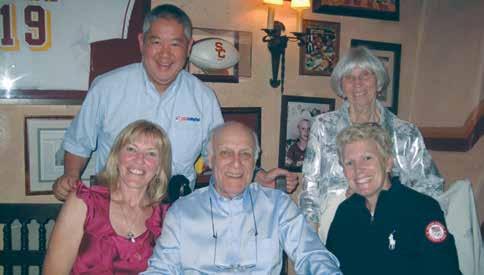
enable discussion of the presentations, allowing time to prepare suggestions for future strategic planning, and calling for papers to provide collegiate sport researchers the opportunity to attend may also enhance future seminars.
Contributors to this evaluation include Elizabeth Hanley and Naghmeh Maryan.
Iversen first attended the IOA in 1986. She attended IOA sessions in Greece
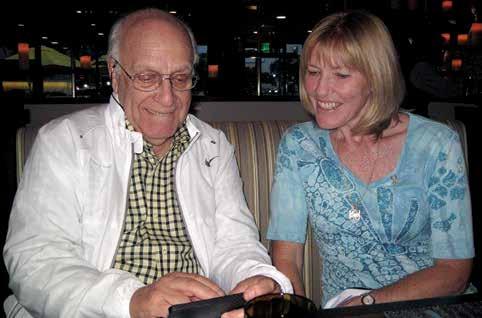
in various capacities (1986-present) as a participant, as a coordinator during the Young Participant’s Session (19972007) and as president and member of the Alumni Association that will celebrate 25 years of existence next year during its 15th Biennial Session in Ancient Olympia. Iversen was a staff member for the USOC’s most recent attempt to revive the USOA and is a two-time Olympian in indoor volleyball.
Hanley attended the inaugural USOA at the University of Illinois, Chicago Circle, in 1977, and subsequent USOA meetings until 1991. Hanley also attended many of the IOA sessions (1977-2004) as dance workshop coordinator, lecturer, discussion group leader and guest. In 2008, she was chosen to attend the IOA Education Session with Dr. Mick Lynch from Florida Southern College. As a founding member of IOAPA, Hanley participated in several meetings from 1991- 2013.
Maryan worked for the NOC of Iran, specializing in Olympic solidarity programs and attended the IOA as a participant, coordinator and member of IOAPA.
Construction has begun on The Crawford Family U.S. Olympic Archives. After over one year and a half of preparation and planning for a new home for our historic U.S. Olympic artifacts, ground has been broken, so to speak. The second floor of USOC headquarters is being enhanced and will house The Crawford Family U.S. Olympic Archives this fall.
The new archives is three times the size of our existing archives and includes three sections of moveable shelving, a hanging art storage system, a room dedicated to photographs, and a special collections vault within the archives itself. In addition, enhanced security
measures and an outward facing display will greet visitors to the archives.
Unfortunately, research access to the archives is closed until after the move (September 2014). However, we continue to answer research requests that are emailed to us. Please note, due to the focus on our move, a delay may occur with our response to your request. However, once we reopen the archives to researchers, a dedicated reading room will be part of the new archives.
Despite the fact that we are closed to onsite researchers, artifacts and items from our Olympians are still desired and
will continue to be processed as we prepare the collection for its new home. Donations of uniforms, credentials, equipment, pins, medals and more are always encouraged to record and capture the history of our Olympians and the Olympic Movement in the United States.
Look to future issues and view the progress as the existing bare walls and floors are transformed into The Crawford Family U.S. Olympic Archives.
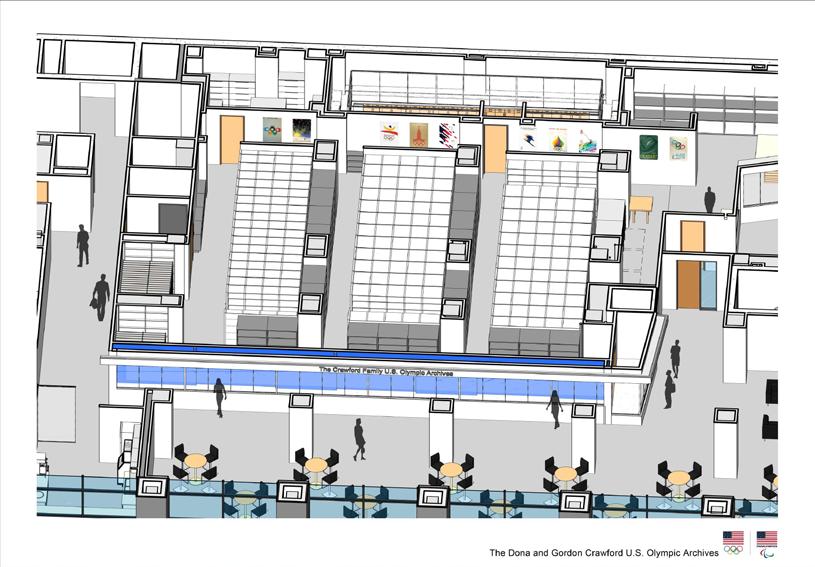


Since the Athens 2004 Olympic and Paralympic Games, Lakeshore has hosted a fundraising event called “Night of Champions” in conjunction with the live televised broadcast of the Olympic Games Opening Ceremony. “Night of Champions” has been an evening corporate event to coincide with the broadcast. Due to the unprecedented broadcast coverage of the Sochi 2014 Paralympic Games Lakeshore felt compelled to strengthen its place as a leader in the Paralympic Movement and created “Spirit of Sochi” to replace Night of Champions.

Due to the Paralympic Opening Ceremony NBC broadcast at noon
“Spirit of Sochi” was a free family festival celebrating the firstever NBC network televised broadcast of the Paralympic Opening Ceremony.
on March 8, 2014, it was decided that “Spirit of Sochi” would shift to a daytime,
Paralympic-type festival event – open to the public and on Lakeshore’s campus from 11:00 a.m.-3:00 p.m.
The “Spirit of Sochi” was a free family festival celebrating the first-ever NBC network televised broadcast of the Paralympic Opening Ceremony. It was an opportunity to showcase Lakeshore Foundation’s position as a leader in the Paralympic Movement and to introduce its Paralympic goal to the greater community while raising funds for Lakeshore’s program support.
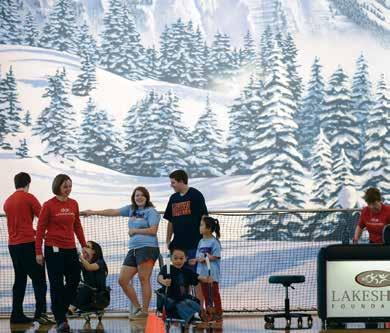
 Around 2500 members of the Birmingham, Alabama community enjoyed a full day of Paralympic and Olympic interactive experiences.
Activities ranged from wheelchair slalom to bobsled to sledge hockey.
Around 2500 members of the Birmingham, Alabama community enjoyed a full day of Paralympic and Olympic interactive experiences.
Activities ranged from wheelchair slalom to bobsled to sledge hockey.
Approximately 2500
Children, seniors, VIP hosts and sponsors of the event, and local politicians
• Liberty Mutual “Road to Sochi” interactive experiences
• Olympians and Paralympians autograph table
• Video screen displaying the Sochi 2014 Paralympic Games Opening Ceremony; Introduced by Birmingham Mayor William Bell
• Wheelchair basketball demonstration: Lakeshore Lakers vs. Auburn University
• Biathlon interactive experience for participants with visual impairment
• Wheelchair slalom and sledge hockey interactive experience
• Russian Culture Experience:
o Balalaika Fantasi: Six Russian musicians performing on stage
o Chervona Kalyna: Three Russian and Ukrainian dancers performing on stage
o Authentic Russian food sampling booth
• Alabama Symphony Orchestra String Trio performing Tchaikovsky
• Face painting, door prizes
School poster contest (122 entries) with winners recognized at event and posters on display in the Lakeshore Fieldhouse Food truck village: Off the Hook, Slice, Cantina, Spoonfed, Dreamcakes, Steel City Pops and Repicci’s Italian Ice and Gelatto.
“Wanted to say what a great day I had with you guys last weekend. The event was great and opened the eyes to many
people about the Winter Olympic Games and Lakeshore. What a great place and great people. I love that organization!” –John Zimmerman, Olympic figure skater
“Spirit of Sochi” has set a new standard at Lakeshore due to the sheer number of guests and the fact that 75 percent of them were first-time visitors to the Lakeshore campus. Success can certainly be defined by more than just event income. The impact of this event will reap long-term benefits for Lakeshore and for the attendees. Across the board, “Spirit of Sochi” has been deemed a tremendous success and will influence the way in which we implement special events in the future.
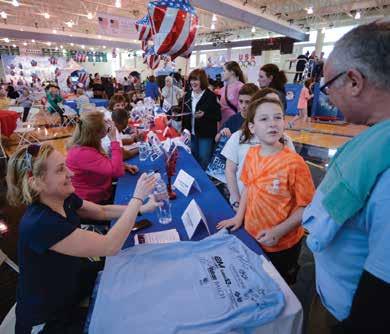

Spirit of Sochi celebrated the Olympic and Paralympic spirit while educating the public about Lakeshore Foundation’s programs and services.
Leading up to the Sochi 2014 Olympic Winter Games, Sage Kotsenburg had no idea he would land on the top of the medal podium. Nor did he have any idea of what an Olympic gold medal would bring to him in terms of post-Games opportunities. Prior to competing in the Olympic Winter Games, he had never even been to New York City before.
It’s safe to say the 20-year-old snowboarder was not expecting to come face to face with the President of the United States.
So, when Kotsenburg, who shocked the snowboarding world by winning the first Olympic gold medal of the Winter Games in Sochi, was preparing for the Team USA athletes’ visit to the White House in April, it was understandable that he was not exactly sure what he would say to President Barack Obama.
As he joked on the “Today” show, Kotsenburg said he would ask the president, “What’s up, dog?”
Kotsenburg, whom the president later described as “chill,” told reporters that he didn’t go through with his “What’s up, dog?” question when he actually met Obama. Instead, he fumbled on a lot of his words to the president and laughed that he said, “thank you” an awful lot. The slopestyle snowboarder also got some goodies from First Lady Michelle Obama’s garden. As he spoke with reporters, he held various greens that he thought were a mix of Brussels sprouts and green beans.
“I think they’re for lunch,” Kotsenburg said with a laugh.
Kotsenburg was one of about 200 Team USA Olympic and Paralympic athletes who visited the White House and got an insider’s tour of the national landmark. Not only was Kotsenburg, in his word, “stoked” about the tour but he was also

excited to be back together with so many of the U.S. athletes he hung out with in Sochi.
The night before the White House tour, Kotsenburg was honored as the Best Male Olympian at the inaugural Best of U.S. Awards show, which was held at the historic Warner Theater.
“It’s pretty much been like a family reunion,” Kotsenburg said of Team USA athletes taking on Washington. “It was kind of like a family over there.”
Among Kotsenburg’s new relatives in the Olympic family are gold medalist skier Mikaela Shiffrin, four-time ice hockey Olympian Julie Chu, and halfpipe skiing gold medalists Maddie Bowman and David Wise — all of whom were among the athletes who made the trip to Washington.
In addition, numerous Paralympians who starred in Sochi were also honored at the Best of U.S. Awards show and at the White House. In fact, the U.S. Paralympic sled hockey team, which knocked off Russia to defend its gold medal, came to the capital and won the Team of the Paralympic Games honor.
Tatyana McFadden, a track & field Paralympic champion who earned a cross-country silver medal in her
Paralympic Winter Games debut in Sochi, and snowboard cross gold medalist Evan Strong were among the Paralympians in attendance.
Although Team USA athletes typically make a visit to Washington and the White House following the Games, even veterans who have been to 1600 Pennsylvania Avenue before said it remains a thrill.
“No it doesn’t get old,” said Chu, who has represented Team USA’s women’s hockey team four times in the Winter Games and was the U.S. flag bearer in the Closing Ceremony in Sochi.
She had the honor – along with Paralympic flag bearer Jon Lujan – of handing President Obama and the First Lady specially signed flags.
Meanwhile, Shiffrin – the skiing star who became the youngest Olympic slalom champion at 18 – was making her first tour through the White House. She took in everything inside the White House, from the architecture to the marble staircases to the china.
“It was mind-blowing to see it all,” Shiffrin said.
President Obama and the First Lady seemed pretty mind-blown by the


On Thursday, April 3, 2014, President Barack Obama and First Lady Michelle Obama addressed members of the United States Olympic and Paralympic teams and delegations at the White House.
athletes who were visiting their home.
“After watching you guys all over TV all these couple of months, I have to say that I am truly amazed,” Michelle Obama told the Team USA athletes in the East Room of the White House. “I shared some of this with you guys in the receiving line. You all are so talented. You’re dedicated, and honestly, sometimes I don’t know how you do it. I really don’t.
“I’ve watched you guys do some of the craziest stuff,” the First Lady added. “That’s the thing with the Winter Olympics. You guys do crazy things — careening down the face of mountains … craziness.
Throwing each other up in the air, it’s like … the mixed pair skaters, the women, they’re teeny. The big guys take them and throw them across the ice. I’m like, ‘Are you kidding me?’ You threw her so hard and she lands on one foot on a blade. And those of you jumping on those cookie sheet things and just sliding down a mountain … 80 miles an hour … I mean, who thinks of that?
“So I am really in awe of everything you do.”
The President joked about learning a new vocabulary during the Sochi Games, which featured so many new sports – many adapted from X Gamesstyle competition such as slopestyle snowboarding and halfpipe skiing.
“I would personally like to thank all of our snowboarders and freestyle skiers for making newscasters across America say things like ‘air to fakie,’ and the ‘backto-back double cork 1260,” President Obama said. “I don’t know what that means, really, but I just wanted to say it. I’m pretty sure I’m the first President to ever say that.”
The President highlighted a variety of the Team USA athletes’ many accomplishments, noting the introduction of women’s ski jumping to the Olympic Winter Games’ program, Noelle Pikus-Pace’s return to skeleton for the silver medal and Shiffrin’s vow to win five gold medals in the next Olympic Winter Games in 2018.
It was “It was mindblowing to see it all,”
Shiffrin said.
“I do have to say, though, Mikaela, as somebody who was once told, ‘You’re young, but you should set your sights high,’ ” I just got three words of advice: Go for it.” President Obama said. “We are confident you are going to be bringing back some more gold.”
One U.S. athlete who was given a big shoutout was Paralympian Dan Cnossen, who had visited the White House four years prior to this visit – not long after a life-jarring accident in Afghanistan when
an improvised explosive device cost him his legs. The First Lady recounted Cnossen’s journey from that moment as a Navy SEAL to his life now as a member of the U.S. Paralympic Team in Sochi.
On the year anniversary of the explosion, Cnossen ran one mile on prosthetics. He went on to win medals in the Warrior Games, and he completed the New York Marathon in 2:38 (handcycling 16 miles and running 10.2 miles). In Sochi, Cnossen competed in cross-country and biathlon events. He continues to serve the country as an active member of the U.S. Navy, and was one of 18 military members on the 80-member 2014 U.S. Paralympic Team.
“He lost both of his legs in the explosion but he never lost his fighting spirit,” Michelle Obama said.
Ultimately, the day had to come to a close, and the athletes, who shared hugs, selfies and updates with their new family members did not want it to end.
“Being with the president was pretty insane,” Kotsenburg said. “Being in there is pretty crazy.”
“I was kind of bummed the experience was over so fast,” he added. “I’m really sad that it ended.”
Then again, there’s a good chance some of these athletes will do it all again for another family reunion in 2018.


The United States Olympic Committee’s Athlete Career and Education Services division hosted its first Olympic and Paralympic Summit April 3-5 in Washington, D.C., at the Doubletree by Hilton Crystal City. The summit was made possible through the support of The Foundation for Global Sports Development, David Pottruck and USOC partners Adecco, DeVry University, Dow and Visa.
The Summit served as the official kickoff to the USOC’s Athlete Career and Education program, which is led by new director Gregg Simmons. Within his first eight weeks at the USOC, Simmons coordinated the event and created the theme for the summit, “Train, compete and succeed in life.” He felt that this theme represents the new direction for the athlete career program and the way in which the services should support Team USA athletes.
77 Sochi Olympians and Paralympians participated in the three-day summit. 2014 team members participated in sessions, workshops and panels lead by Olympians and Paralympians along with sponsors, career professionals, employers and USOC staff.
Topics included:
• Transitioning from an athlete’s perspective
• Approaching life after the Olympic and Paralympic Games
• Preparing for success on the corporate playing field
• Understanding business ownership and non-profit careers
• How do I manage training, competition and my transition
• Professional development and situational leadership
• Practical money skills for life
• Career management – improves performance and improves your life
• Building your team and your network

o lympi C & p aralympi C sU mmit B y t H e n U m B ers
2014 Olympians – 60
• Biathlon – three
• Bobsled/Skeleton – six
• Curling – five
• Figure Skating – three
• Ice Hockey – nine
• Luge – seven
• Ski and snowboard – 17
• Speedskating – 10
2014 Paralympians – 21
• Ski and snowboard – 5
• Sled Hockey – 14
• Wheelchair Curling – 2
Medalists – 31
• Gold – 14
• Silver – 11
• Bronze – 6
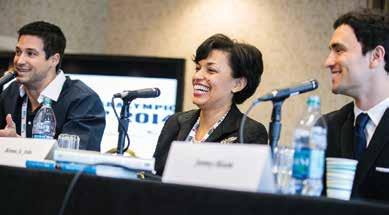

The panel was moderated by Foundation for Global Sports Development Olympian, Kathy Johnson Clarke (Gymnastics, 1980, 1984).
For more info on the Athlete Career & Education Program: ACEP@usoc.org

Elana
Elana Meyers and Nic Taylor met through bobsled in 2011 and began dating. Taylor proposed to Meyers at the medal podium of the 2013 World Championships. Their wedding didn’t pass without references to the sport, either.
“When they gave their personal vows, a lot of the audience probably didn’t understand,” said Olympic teammate Jazmine Fenlator, one of about 75 people at the Douglasville, Ga., gathering. “It was a lot of bobsled and training innuendos. You know, I’ll stand with you whenever you’re gluten-free and dairy-free, which is the nutrition plan when we’re in season.”
Fenlator remembered them saying at the end, “Now let’s go have some fun,” and gave each other high-fives, just as Meyers does at the start line with her brakemen before her bobsled heats.
Meyers, a two-time Olympic medalist, and Taylor, a former U.S. bobsled athlete, began life as a married couple by traveling to Washington and then New York. First, Meyers had her college softball jersey retired by George Washington University. They flew to New York for Right To Play’s Big Red Ball on Wall Street.
“The whole goal of the wedding was to get [Taylor] to cry,” Meyers said at the Right to Play gala. “He didn’t cry. He was too excited.”
“I was close the entire time, but I was so happy,” said Taylor. “It was the most fun I have ever had. Although I was a little choked up, never got around to crying, which I’m pretty excited about.”
Your Donation
Your donation will help us provide, but not limited to, needed medical assistance, prescription medication, replacement of stolen articles, or automobile repair for Olympians who have fallen victim to accident, illness, or injury.
How is it spent?
Once approved by our board of Olympians, the grants will allow individuals who have served this country with distinction, to return to a life of active and productive engagement.
The OORF is staffed entirely by US Olympians who volunteer their time and energy. 100% of all donations go directly to providing assistance to America’s Olympic heroes, and the US Olympic Committee has been matching each gift, dollar for dollar.
Past recipients have told us that the OORF grant has made it possible to recover more quickly from surgeries, lost jobs and catastrophic accidents. These gifts have reminded our recipients that their service on the US Olympic team has not been forgotten, and in many cases has also reconnected them to the Olympic Family.
DONATIONS ARE TAX DEDUCTIBLE


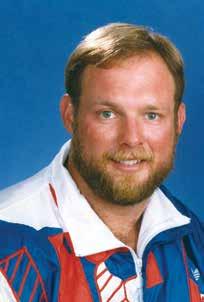
Robert Billingham died on March 30, 2014. He was 56 years old.
His record included representing the United States at the 1988 Olympic Games, winning the silver medal in the soling class with John Kostecki and Will Baylis. He is a five-time world champion in solings, etchells, J/24s and maxis and served on the management side of the U.S. Olympic team for 20 years.
Billingham’s involvement in the America’s Cup included crewing on the 1992 America’s Cup winning team, America3, before assuming roles as chief operating officer for Paul Cayard at AmericaOne 2000 and Artemis Racing. Prior to the 34th America’s Cup, he worked for the America’s Cup event organizers in San Francisco, preparing facilities to host cup racing in 2012 and 2013.
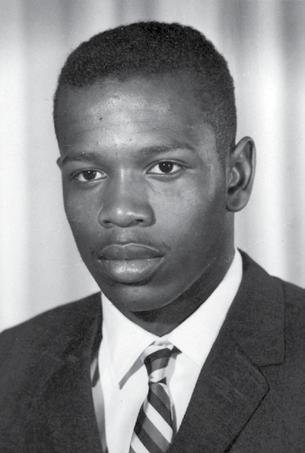
Francis Budd died on April 29, 2014. He was 74 years old.
In just 9.2 seconds on June 24, 1961, he proved himself the fastest man on earth. Winning the gold medal in the 100-yard dash at the national AAU championships, held at Downing Stadium on Randall’s Island in New York, the Villanova junior took one tenth of a second off the world record that had been in the books for more than 14 years. He often got around in a motorized wheelchair, but he was forever remembered as the onetime “world’s fastest human.”
He was an Olympic sprinter as a Villanova sophomore – placing fifth in the 100-meter final at the Rome 1960 Olympic Games –a world-record man at 100 and 220 yards, a three-time National Collegiate Athletic Association champion and seven-time IC4A winner.
He never played football in college, but became a wide receiver in the National Football League for the Philadelphia Eagles and the Washington Redskins. He also played for three years in the Canadian Football League.
At Villanova, the Asbury Park, N.J., star was honored as a member of the inaugural Wall of Fame.
He is survived by his wife, Barbara; his children, Frank Jr., Kimberly Arzillo and Anitra Spreight; nine grandchildren and five great-grandchildren.

Philip Ransom Conley died on March 14, 2014. He was 79 years old.
He was raised in Fresno, Calif., and earned a bachelor of science in mechanical engineering in 1956 from the California Institute of Technology in Pasadena, Calif.

At Cal Tech, Conley played quarterback and was a starter on the basketball team, securing all-conference honors in both sports. After taking up javelin in college, he set numerous records.
Conley was elected student body president his senior year, and that same year made the U.S. Olympic team, where he competed in the javelin throw in Melbourne, Australia. Three years later, he competed in the Pan American Games, taking home the javelin silver medal. After he continued to compete well into the 1960’s, Phil was elected to the Masters Track & Field Hall of Fame and the Fresno Athletic Hall of Fame.
He is survived by his beloved wife, Fran, and cousin, Sally Matthews.

Jean Jacques Gillet
Coach, 1976)
Jean Jacques Gillet died in France on March 14, 2014. He was 87 years old.
Jean-Jacques Gillet was assistant coach of Cornell under Raoul Sudre from 1969 to 1976 and succeeded him as head coach from 1976-1988. During Gillet’s tenure at Cornell, the men’s team was runnerup in the 1975 NCAA championship and the women’s team won the NIWFA championship in 1972 and 1973 and was runner-up in 1974.
Gillet had one of the most varied coaching careers in our sport. He became a military instructor in physical education while earning a brown belt in judo. He also became a rated official in track and basketball as well as an instructor in glider flying. He was a coach and organizer in modern pentathlon for the French Air Force from 1955 to 1960. Finally, he held a commercial pilot’s license and was qualified on more than 20 different types of gliders and airplanes and had more than 4,000 hours of flying time.
Gillett emigrated to the U.S. and became assistant fencing coach and judo instructor at Cornell in 1969. In his association with Cornell’s varsity teams and the American Fencing Academy in Ithaca, he spent 20 years developing fencers and fencing masters for the U.S., Canada, and Australia.
Gillet was selected U.S. Olympic coach at Montreal in 1976. He was twice elected president of the US Fencing Coaches Association, serving from 19861990. Gillet concurrently held the vicepresidency of the International Academy of Arms (AAI) the international federation of national fencing masters associations, and was chairman of its Commission on Pedagogy.
Gillet had resided in France since retiring from Cornell. For his many and varied
accomplishments, Gillet was decorated by the French government with the Silver Medal of Youth and Sport in 1993.

Thomas Jacobs died on April 10, 2014. He was 87 years old.
The Olympic skier – a warm-hearted and cold-weather sport enthusiast – was ahead of the curve throughout his life. Jacobs patented dozens of products, including the first modern slalom flex pole that revolutionized slalom ski racing.
He was selected to the Oslo 1952 U.S. Olympic Team and finished 21st in the Nordic combined event. When he returned to the U.S., he was hired as Colorado University’s first full-time ski coach. He also served as chairman of the National Collegiate Athletic Association Committee on skiing and authored the “National Collegiate Athletic Association Ski Rules” book.
(Fencing
In 1958, he moved his family to Glens Falls, N.Y., to work at Finch, Pryun and Co., but continued to stay involved in the ski scene. He directed the ski school at Hickory Hill and helped start the ski school at West Mountain – forming the Southern Adirondack Junior Racing League. Jacobs and his wife opened and operated West Mountain’s first ski shop. In 1969, he retired from his sales position at Finch and moved his shop to downtown Glens Falls.
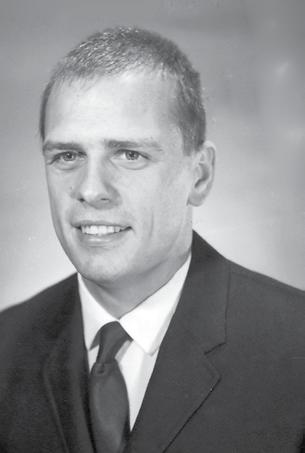
Chester “Chet” Jastremski (swimming, 1964, 1968)
Chester Jastremski died on May 3, 2014. He was 73 years old.
He swam at Indiana University under legendary swim coach James “Doc” Councilman in 1960, where he set world records in four breaststroke events eight separate times and was featured on the cover of Sports Illustrated as the world’s
best swimmer. In 1963, he won the gold medal in the 200-meter breaststroke at the Sao Paulo Pan American Games.
Jastremski was the first swimmer to break the one-minute barrier in the 100-yard breaststroke and set 12 world records and 21 American records.
He won the bronze medal in the 200-meter breaststroke at the 1964 Olympic Games and qualified for the 1968 Olympic Games as an alternate in the 100-meter breaststroke after only two months of training. His Olympic involvement continued, serving as the team doctor for the 1976 U.S. Olympic swim team He was inducted into the International Swimming Hall of Fame in 1977, the Polish-American Hall of Fame in 2007 and the Indiana University Athletic Hall of Fame in 1983 for his accomplishments and efforts.
After graduating from Indiana University medical school in 1968, he became a U.S. Army doctor until 1972, and then established a medical practice in Bloomington, Ind. He retired from medicine in 1979 and began teaching at IU, where he also served as head coach for the Indiana University women’s swim team from 1987-1991.
Jastremski is survived by his wife, Connie; daughters, Kelly and Andrea; son, Ted; stepchildren, Rob, Kim and Tiffany; brother, Duane (Bobbie); 15 grandchildren and a host of nieces, nephews and cousins.
He is preceded in death by his parents and stepson, Nicholas Fritz.

Gerry Rimoldi (Cycling coach, 1968, 1972)
James Gerry Rimoldi died on March 3, 2014. He was 79 years old.
Gerry lived in San Diego, Calif., where he enjoyed biking, hiking, water rafting, fly fishing and NASCAR and was the owner of College Schwinn Cyclery.
He served as the Olympic cycling coach for Team USA at the 1968 and 1972 Olympic Games.
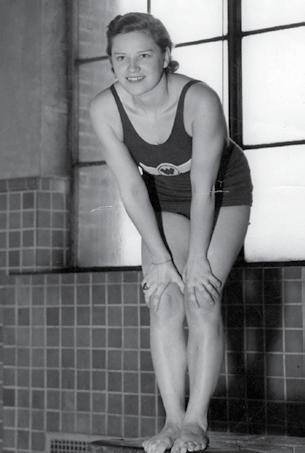
Mary Lou Petty-Skok died on April 2, 2014. She was 98 years old.
She was an adept swimmer at eight and began swimming competitively at 13. She originally prepared to compete in the 1932 Olympic Games, but the Great Depression prevented her from acquiring the necessary financial backing. After her engagement to Bob Skok, she moved to Seattle and qualified for the 400-meter freestyle at the 1936 Olympic Games. During this Olympic period, she set several national records.
Upon her return from the Games, she married Bob and eventually moved to Los Angeles after he decided to pursue optometry. The two remained together until his death in 1998.
She is preceded in death by her parents, Mary F. Watkins Petty, Walter E. Petty Sr.; brother, Walter Petty Jr.; daughter, Barbara Lee Skok-Baker; and dog, Bailey. She is survived by her daughter, Helen Skok-Munger; grandchildren, Michelle Van Amburg, Chris Munger, Lynn
Perry, Robin Munger, Ted Baker, Leslie Russell and Tracey Baker; and 17 great grandchildren, Ryan, Brandon, Danielle, Austin, Devyn, Trevor, Tyler, Bobbi, Sorcha, Christian, Carli, Garrett, Dillon, Olivia, Grace, Aaron and Jordan.

David J. Smith died on March 8, 2014. He was 88 years old.

He was a graduate of St. John’s Preparatory School. Following High School, he entered the United States Navy and served his country during World War II. When he returned from his tour of duty with the Navy, he graduated from the University of Massachusetts, Amherst in the class of 1950.
He enjoyed being close to the water, and his passion was sailing. He became an excellent yachtsman. During the Rome 1960 Olympic Games, he earned the gold medal in the 5.5 class racing. He had also sailed in the America’s Cup trials in 1962 as bowman on 12-meter yacht Nefertiti.
Smith was the owner and proprietor of the Fife and Drum Stores in Marblehead, M.D., which specialized in yacht wear. While operating the stores, he started his own manufacturing operation in Salem, Ore., at the Pequot Mills Shetland Properties. He eventually closed his retail store and put all of his interests into his manufacturing company, YRI.
He is survived by his wife, Sally; two children, Judson and Tamis; grandchildren, Haley Swain, Lindsay Smith, Darby Smith and Lindy Miller; and several nieces and nephews.


Walter Rudolph Walsh died on April 29, 2014. He was 106 years old.
Walter was a former Federal Bureau of Investigation agent, United States Marine Corps officer and U.S. Olympian.
He joined the FBI in 1934, serving during the gangster era of the 1930s and was involved in several high-profile cases, including the capture of Arthur “Doc” Barker and Al Brady. He later served with the Marines in the Pacific Ocean during World War II. After a brief return to the FBI, he continued his service in the Marine Corps, where he was Commanding Officer, Weapons Training Battalion, Marksmanship Training Unit, Marine Corps Schools. In this role, he was responsible for small arms training programs in the Marine Corps as well as the Marine Corps competitive shooting program. Walsh served in this capacity until his retirement in 1969.
As a world-class, distinguished shooter, he won numerous tournaments locally, regionally, nationally and internationally. He participated in the 1948 Olympic Games, served as coach of the U.S. Olympic shooting team until 2000, while also competing in and coaching a number of Pan American Games and world championship teams.
At the FBI’s 100th birthday celebration, it was noted that he was one year older than the organization. Col. Walsh remained physically fit throughout his life, and, in March 2013, he was recognized as the longest living Olympic competitor, the oldest Marine and the oldest FBI agent.
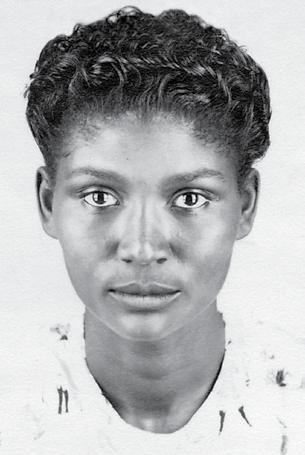

Emma Reed Wright died on April 4, 2014. She was 88 years old.
Born to Smith and Sallie Reed in Vicksburg, Miss., she earned a bachelor’s
degree in health and physical education from Tennessee State University and a master’s degree in education from New York University. In 1948, she was selected to represent the United States in track & field at the London Olympic Games.
Her teaching career included several years at Barber Scotia College in North Carolina and later, after moving to Washington, D.C., many years in the Montgomery County Public School System. Her retirement years involved working with several youth groups in the D.C. area. An avid tennis player, she coached and participated with athletic groups.
Wright will be remembered for her love and support of family and friends and her generosity for those in need. She is survived by her sister, Sallie Williams and a number of nieces and nephews.
Emma Reed Wright (Track & Field, 1948)
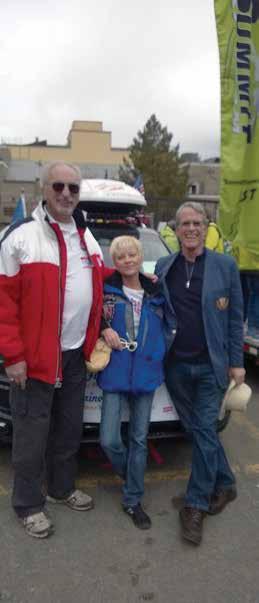

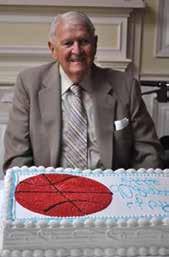
1. From left to right: Blaine Lindgren (track & field, 1964), Debra Clark (gymnastics, 1972) and Dick Roth (swimming, 1964), attended the Park City Community Olympic & Paralympic Homecoming Parade and Celebration on April 5, 2014.
2. Richard W. Pew (fencing, 1956) with his beautiful family. Three married children and eight grandchildren. He is a very proud man. He is the handsome one in the back with the orange tie and blue blazer
3. Raymond George “Ray” Lumpp, 1948 basketball gold medalist celebrated his 90th birthday with family and friends.
4. 1964 U.S. Men’s and Women’s Olympic Volleyball Teams
Front row from left to right: Lou Sara ClarkMcWilliams, Sharon Peterson, Mardi Osborne, Diana Hoffman, Pete Velasco, Nancy Owen Fortner, Jane Ward and Rolf Engen. Back row from left to right: Ernie Suwara, Linda Murphy, Mike O’Hara, Rudy Suwara, Barry Brown, Bill Griebenow, Verneda Thomas and Butch May

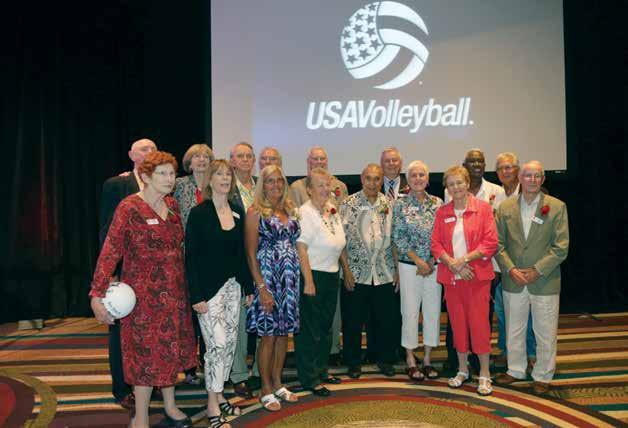

USOC CHAIRMAN
Larry Probst
Robert Bach
James Benson
Scott A. Blackmun
Bob Bowlsby
Ursula M. Burns
Anita L. DeFrantz (rowing, 1976, 1980)
James L. Easton
John S. Hendricks
Nina Kemppel (cross-country skiing, 1992, 1994, 1998, 2002)
Susanne Lyons
Bill Marolt (alpine skiing, 1964)
Mary McCagg (rowing, 1992, 1996)
Dave Ogrean
Whitney Ping (table tennis, 2004)
Angela Ruggiero (ice hockey,1998, 2002, 2006, 2010)
USOC CHIEF EXECUTIVE OFFICER
Scott A. Blackmun
U.S. OLYMPIANS & PARALYMPIANS OFFICERS 2013-16
PRESIDENT
Gary Hall, Sr. (swimming, 1968, 1972, 1976)
VICE PRESIDENTS
Carol Brown (rowing, 1976, 1980, 1984)
Joey Cheek (speedskating, 2002, 2006)
Dick Fosbury (track & field, 1968)
Micki King (diving, 1968, 1972)
Carol Lewis Zilli (track & field, 1984, 1988)
Greg Louganis (diving, 1976, 1980, 1984, 1988)
Eli A. Wolff (Paralympic soccer, 1996, 2004)
IMMEDIATE PAST PRESIDENT
Willie Banks (track & field, 1980, 1984, 1988)
PAST PRESIDENTS
John Naber (swimming, 1976)
Bill Toomey (track & field, 1968)
EDITORIAL STAFF
SENIOR EDITOR
Cynthia E. Stinger (team handball, 1984, 1988, 1992)
ASSOCIATE EDITOR
Christine Taylor
PRODUCTION DIRECTOR
O’Shea Design
Photos
Alabama Olympians & Paralympians
President: Jennifer Chandler Stevenson (diving, 1976) (205) 313-7436
Arizona Olympians & Paralympians
Presiding Officer: Misty Hyman (swimming, 2000) (650) 248-6359
Colorado Olympians & Paralympians
Presiding Officer: Gene Kotlarek (ski jumping 1960, 1964) (303) 807-3911
Florida Olympians
President: Carrie Zimmerman (gymnastics, 1976) (850) 212-7846
Georgia Olympians & Paralympians
President: Bob Pickens (wrestling, 1964) (773) 425-3254
Hawaii Olympians
President: Kathy Hammond Lohman (track & field, 1972) (808) 395-2446
Houston Olympians & Paralympians
President: Jacqueline Washington (track & field, 1984) (832) 488-8573
Idaho Olympians & Paralympians
President: Dick Fosbury (track & field, 1968) (208) 720-2352
Indiana Olympians
President: Ollan Cassell (track & field, 1964) (317) 466-0444
Michigan Olympians & Paralympians
President: Judi Brown Clarke (track & field, 1984) (517) 881-6710
Midwest Olympians & Paralympians
President: Diane Simpson (rhythmic gymnastics, 1988) (847) 452-7843
Missouri/Illinois Olympians & Paralympians
President: John Carenza (soccer, 1972) (314) 846-4124
National Capital Area Olympians
President: Arlene Limas (taekwondo, 1988) (540) 720-1988
Nevada Olympians & Paralympians
President: Dean Willeford (water polo, 1968) (775) 827-1775
New England Area Olympians & Paralympians
President: Sharon Ann Jewell (taekwondo, 1988) (404) 668-7896
New Mexico Olympians & Paralympians
President: Trent Dimas (gymnastics, 1992) (505) 850-2956
Northern California Olympians
President: Greg Massialas (fencing, 1980, 1984, 1988) (415) 441-0521
Oregon Olympians & Paralympians
President: Lisa Kosglow (snowboarding, 1998, 2002) (541) 400-9061
Southern California Olympians
President: Tamara Christopherson (canoe/kayak, 2000) (206) 605-9265
Southwest Olympians & Paralympians
President: Sammy Walker (weightlifting, 1976) (469) 955-3158
Tri-States Olympians
President: Diane Dixon (track & field, 1984, 1988) (917) 538-3195
Utah Olympians
President: Debra Stark (gymnastics, 1972) (801) 369-9918
Washington Olympians
President: John Stillings (rowing, 1984) (206) 440-0708
Western PA-OH-WV Olympians
President: Julie Koons (speedskating, 2002) (216) 346-2650
No chapter in your area?
Interested in starting a chapter?
Contact the U.S. Olympians & Paralympians Association office for details at: (800) 717-7555